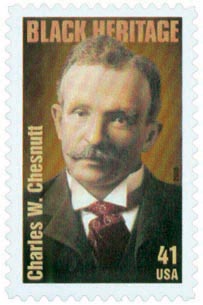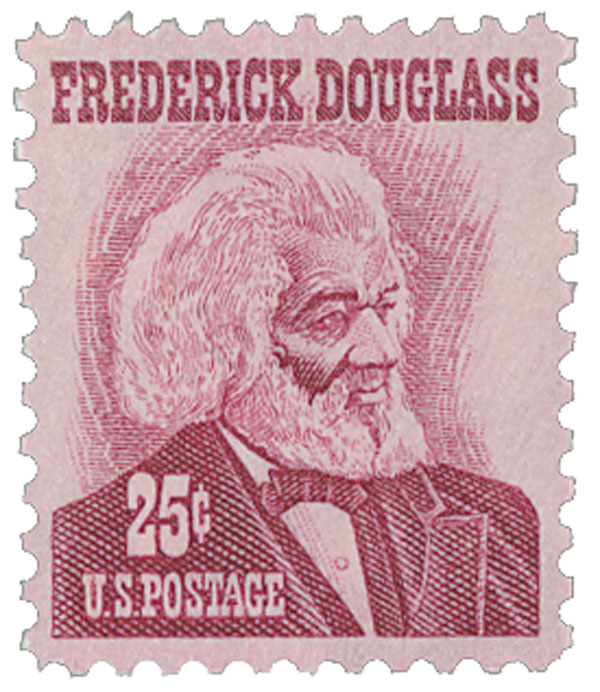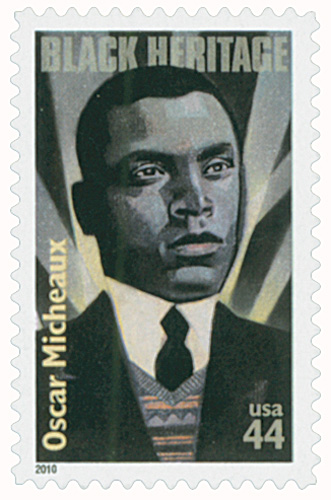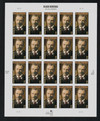
# 4222 - 2008 41c Black Heritage: Charles W. Chesnutt
Charles W. Chesnutt
Black Heritage Series
Issue Date: January 31, 2008
City: Cleveland, OH
Charles Waddell Chesnutt was born on June 20, 1858, in Cleveland, Ohio. He was a critically-acclaimed author and the first African American novelist to have his work published in the prestigious Atlantic Monthly Magazine. The son of free blacks, the family had moved to that city from Fayetteville, North Carolina, because of increasing racial tensions building in the South before the Civil War. When the war ended, the family returned to Fayetteville. At the age of eight, Chesnutt began to attend the Howard School, which his father helped found. Over time, the school evolved from a grade school to a high school and finally into North Carolina’s second publicly funded University – Fayetteville State University. Chesnutt also worked at his father’s store until he was 14. When forced to leave school because of family hardships, Chesnutt continued his education on his own, studying Latin, German, algebra, literature, and history. He went on to become his former school’s assistant principal in 1877, and then its principal from 1880 to 1883. In 1883, discouraged and embittered by racial prejudice, Chesnutt moved to Cleveland, Ohio. There he was able to pursue his dream of becoming an author, while working to change racial bigotry. In his own words, “I will live down the prejudice, I will crush it out. I will show to the world that a many may spring from a race of slaves, and yet far excel many of the boasted ruling race.” Chesnutt had learned stenography when he was younger and began studying law, passing the bar exam in 1887. He soon opened a successful court reporting (legal stenography) business. Also in 1887, Chesnutt became the first black novelist to have his fiction published in the prestigious Atlantic Monthly magazine. Two years later, Chesnutt published his first two collections of short stories, The Conjure Woman and The Wife of His Youth and Other Stories of the Color-Line. His stories were considered much more complex than other writers of his time. Chesnutt explored the issues of mixed race, illegitimacy, racial identity, class preference, and more. Chesnutt also wrote a biography of Frederick Douglass. In 1900, Chesnutt published his first novel, The House Behind the Cedars, with the encouragement of The Atlantic editors. He followed that with The Marrow of Tradition (1901), which was based on the 1898 Wilmington Coup and Massacre. That novel has been called “probably the most astute political-historical novel of its day.” Chesnutt’s novels were critically acclaimed, but weren’t as popular with the public as his short stories. So, he was never able to make a living solely as a writer, but he did continue to write. He published his final novel, The Colonel’s Dream, in 1905. That same year, he achieved enough celebrity status, to be on the guest list of Mark Twain’s 70th birthday party in New York City. Beginning in the early 1900s, Chesnutt focused less on writing and more on his court reporting business and social and political activism. He helped found the NAACP and wrote stories for its magazine, The Crisis. In the 1920s, Oscar Micheaux adapted two of Chesnutt’s stories into films – The Conjure Woman was the basis for the film The Spider’s Web, and The House Behind the Cedars inspired The Millionaire. Also in the 1920s, Chesnutt received the NAACP’s Spingarn Medal for his life’s work. Chesnutt died on November 15, 1932. Long after his death, several of Chesnutt’s works were published posthumously. Interest in his work was also revived during the Civil Rights Movement of the 1960s, and in 1987, his alma mater built and named a library in his honor.Birth of Charles W. Chesnutt





Charles W. Chesnutt
Black Heritage Series
Issue Date: January 31, 2008
City: Cleveland, OH
Charles Waddell Chesnutt was born on June 20, 1858, in Cleveland, Ohio. He was a critically-acclaimed author and the first African American novelist to have his work published in the prestigious Atlantic Monthly Magazine. The son of free blacks, the family had moved to that city from Fayetteville, North Carolina, because of increasing racial tensions building in the South before the Civil War. When the war ended, the family returned to Fayetteville. At the age of eight, Chesnutt began to attend the Howard School, which his father helped found. Over time, the school evolved from a grade school to a high school and finally into North Carolina’s second publicly funded University – Fayetteville State University. Chesnutt also worked at his father’s store until he was 14. When forced to leave school because of family hardships, Chesnutt continued his education on his own, studying Latin, German, algebra, literature, and history. He went on to become his former school’s assistant principal in 1877, and then its principal from 1880 to 1883. In 1883, discouraged and embittered by racial prejudice, Chesnutt moved to Cleveland, Ohio. There he was able to pursue his dream of becoming an author, while working to change racial bigotry. In his own words, “I will live down the prejudice, I will crush it out. I will show to the world that a many may spring from a race of slaves, and yet far excel many of the boasted ruling race.” Chesnutt had learned stenography when he was younger and began studying law, passing the bar exam in 1887. He soon opened a successful court reporting (legal stenography) business. Also in 1887, Chesnutt became the first black novelist to have his fiction published in the prestigious Atlantic Monthly magazine. Two years later, Chesnutt published his first two collections of short stories, The Conjure Woman and The Wife of His Youth and Other Stories of the Color-Line. His stories were considered much more complex than other writers of his time. Chesnutt explored the issues of mixed race, illegitimacy, racial identity, class preference, and more. Chesnutt also wrote a biography of Frederick Douglass. In 1900, Chesnutt published his first novel, The House Behind the Cedars, with the encouragement of The Atlantic editors. He followed that with The Marrow of Tradition (1901), which was based on the 1898 Wilmington Coup and Massacre. That novel has been called “probably the most astute political-historical novel of its day.” Chesnutt’s novels were critically acclaimed, but weren’t as popular with the public as his short stories. So, he was never able to make a living solely as a writer, but he did continue to write. He published his final novel, The Colonel’s Dream, in 1905. That same year, he achieved enough celebrity status, to be on the guest list of Mark Twain’s 70th birthday party in New York City. Beginning in the early 1900s, Chesnutt focused less on writing and more on his court reporting business and social and political activism. He helped found the NAACP and wrote stories for its magazine, The Crisis. In the 1920s, Oscar Micheaux adapted two of Chesnutt’s stories into films – The Conjure Woman was the basis for the film The Spider’s Web, and The House Behind the Cedars inspired The Millionaire. Also in the 1920s, Chesnutt received the NAACP’s Spingarn Medal for his life’s work. Chesnutt died on November 15, 1932. Long after his death, several of Chesnutt’s works were published posthumously. Interest in his work was also revived during the Civil Rights Movement of the 1960s, and in 1987, his alma mater built and named a library in his honor.Birth of Charles W. Chesnutt

















